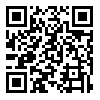Volume 15, Issue 2 (Summer-Fall 2021)
IJOP 2021, 15(2): 179-186 |
Back to browse issues page
Department of Physics, University of Tabriz, Tabriz, Iran
Abstract: (2039 Views)
We theoretically analyze the sensing properties of a one-dimensional photonic crystal-based biosensor for detecting cancer cells infiltrated in a defect cavity layer. The biosensor consists of a sample cavity layer sandwiched between two identical photonic crystals of Hgba2Ca2Cu3O8+d and GaAs. We use the transfer matrix method to evaluate the performance of the biosensor. We show that a defect mode appears in the transmission spectrum of the biosensor that its position depends on the type of cancer cells in the cavity layer. The analysis is carried out by comparing the transmittance peaks of the cancer cells with the normal cells. We investigate the performance of the biosensor under different hydrostatic pressures and temperatures. We show that one can use temperature change to fine-tune the frequency of the defect modes. In addition, we can adjust the working area of the biosensor by changing the hydrostatic pressure. It is shown that the sensitivity of the biosensor is independent of the temperature, while it strongly depends on the hydrostatic pressure.
Keywords: biosensor, defect mode, hydrostatic pressure, photonic crystal, semiconductor, superconductor, temperature.
Type of Study: Research |
Subject:
Special
Received: 2021/09/5 | Revised: 2022/02/7 | Accepted: 2022/02/9 | Published: 2022/06/22
Received: 2021/09/5 | Revised: 2022/02/7 | Accepted: 2022/02/9 | Published: 2022/06/22
References
1. Y. Chang, Y. Jhu, and C. Wu, "Temperature dependence of defect mode in a defective photonic crystal," Opt. Commun. Vol. 285, pp. 1501-1504, 2012. [DOI:10.1016/j.optcom.2011.10.053]
2. Y. Liu and H.W.M. Salemink, "All-optical on-chip sensor for high refractive index sensing in photonic crystals," Europhys. Lett. Vol. 107 pp. 34008 (1-5) , 2014. [DOI:10.1209/0295-5075/107/34008]
3. S. Zheng, B. Shan, M. Ghandehari, and J. Ou, "Sensitivity characterization of cladding modes in long-period gratings photonic crystal fiber for structural health monitoring," Measurement, Vol. 72, pp. 43-51, 2015. [DOI:10.1016/j.measurement.2015.04.014]
4. Y. Zhang, Y. Zhao, and Q. Wang, "Measurement of methane concentration with cryptophane E infiltrated photonic crystal microcavity," Sens. Actuators B: Chem. Vol. 209, pp. 431-437, 2015. [DOI:10.1016/j.snb.2014.12.002]
5. Singh, K.B. Thapa, and N. Kumar, "Analysis and design of optical biosensors using one-dimensional photonic crystals," Optik, Vol. 126, pp. 244-250, 2015. [DOI:10.1016/j.ijleo.2014.08.172]
6. J.D. Joannopoulos, P.R. Villeneuve, and S. Fan, "Photonic crystals: putting a new twist on light," Nature, Vol. 386, pp. 143-149, 1997. [DOI:10.1038/386143a0]
7. E. Yablanovitch, "Photonic crystals: semiconductors of light," Sci. Am. Vol. 285, pp. 46-55, 2001. [DOI:10.1038/scientificamerican1201-46]
8. J.C. Knight, J. Broeng, T. Birks, and P. Russell, "Photonic band gap guidance in optical fibers," Science, Vol. 282, pp. 1476-1478, 1998. [DOI:10.1126/science.282.5393.1476] [PMID]
9. B. Suthar and A. Bhargava, "Temperature-dependent tunable photonic channel filter," IEEE Photon. Technol. Lett. Vol. 24, pp. 338-340, 2012. [DOI:10.1109/LPT.2011.2178401]
10. P. Lalanne, C. Sauvan, and J.P. Hugonin, "Photon confinement in photonic crystal nanocavities," Laser Photonics Rev. Vol. 2, pp. 514-526, 2008. [DOI:10.1002/lpor.200810018]
11. A.B. Suthar and A. Bhargava, "Biosensor Application of One-Dimensional Photonic Crystal for Malaria Diagnosis," Plasmonics, Vol. 16, pp. 59-63, 2021. [DOI:10.1007/s11468-020-01259-8]
12. J. Li, T. Tang, Y. Zhang, L. Luo, and P. Sun, "Magneto-plasmonic sensor with one dimensional photonic crystal for methane detection," Optik, Vol. 155, pp.74-80, 2018. [DOI:10.1016/j.ijleo.2017.10.156]
13. A. Soltani, F. Ouerghi, F. AbdelMalek, and S. Haxha, "Comparative study of one-dimensional photonic crystal heterostructure doped with a high and low-transition temperature superconducting for a low-temperature sensor," Opt. Commun. Vol. 445, pp. 268-272, 2019. [DOI:10.1016/j.optcom.2019.04.056]
14. A.M. Soto and C. Sonnenschein, "Environmental causes of cancer: endocrine disruptors as carcinogens," Nat. Rev. Endocrinol, Vol. 6, pp. 363-370, 2010. [DOI:10.1038/nrendo.2010.87] [PMID] [PMCID]
15. C. Alibert, B. Goud, and J.B. Manneville, "Are cancer cells really softer than normal cells?," Biol. Cell, Vol. 109, pp. 167-189, 2017. [DOI:10.1111/boc.201600078] [PMID]
16. M.A. Jabin, K. Ahmed, M.J. Rana, B.K. Paul, M.M. Islam, D. Vigneswaran, and M.S. Uddin, "Surface plasmon resonance based titanium coated biosensor for cancer cell detection," IEEE Photon. J. Vol. 11, pp. 1-10, 2019. [DOI:10.1109/JPHOT.2019.2924825]
17. L. Gonzalez, J. Ordonez, G. Zambrano, and N. Porras-Montenegro, "YBa2Cu3O7-x/BaTiO3 1D superconducting photonic crystal with tunable broadband response in the visible range," J. Supercond. Novel Mag. Vol, 31, pp. 2003-2009, 2018. [DOI:10.1007/s10948-017-4427-4]
18. G.A. Samara, "Temperature and pressure dependences of the dielectric constants of semiconductors," Phys. Rev B. Vol, 27, pp. 3494-3505, 1983. [DOI:10.1103/PhysRevB.27.3494]
19. M. Tinkham, Introduction to Superconductivity, New York: McGraw-Hill, 1996. [DOI:10.1063/1.2807811]
20. A. Yamamoto, N. Takeshita, C. Terakura, and Y. Tokura, "High pressure effects revisited for the cuprate superconductor family with highest critical temperature," Nat. Commun. Vol. 6, pp. 8990 (1-7), 2015. [DOI:10.1038/ncomms9990] [PMID] [PMCID]
21. N. Takeshita, A. Yamamoto, A. Iyo, and H. Eisaki, "Zero resistivity above 150 K in HgBa2Ca2Cu3O8+δ at high pressure," J. Phys. Soc. Jpn. Vol. 82, pp. 023711 (1-4), 2013. [DOI:10.7566/JPSJ.82.023711]
22. G. Samara, "Temperature and pressure dependences of the dielectric constants of semiconductors," Phys. Rev. B, Vol. 27, pp. 3494-3505, 1983. [DOI:10.1103/PhysRevB.27.3494]
23. A. Elabsy, "Hydrostatic pressure dependence of binding energies for donors in quantum well heterostructures," Phys. Scr. Vol. 48, pp. 376-378, 1993. [DOI:10.1088/0031-8949/48/3/019]
| Rights and permissions | |
 |
This work is licensed under a Creative Commons Attribution-NonCommercial 4.0 International License. |




